Outdoor Adventure
7 Best Sport Earbuds (2025)
When I was younger I had a high-adrenaline running playlist that I carefully curated: Arctic Monkeys, Jay-Z, Rage Against the Machine. It got my heart rate up, the same way drinking a lot of coffee made me more productive. As podcasts became a thing—and I decided a more moderate heart rate has its upsides—I seized the chance to explore ideas while trying to hit my weekly mile goals. What remained constant was my appreciation for the evolution of earbuds, from wired to wireless, from basic to loaded, with features like active noise cancellation, and always toward better and better sound. So it is a delight to be able to test and select the best-performing sport earbuds on the market.
Update March 2025: We’ve tested and selected new sport earbud models in six categories, including a new best overall pick of the Bose QuietComfort.
The Hottest Trend in Sport Earbuds
This year’s hottest trend is open earbuds, which allow you to hear far more of what’s going on around you, and I can’t say I’ve been sold on them. There’s no doubt that they make a lot of sense for people who run along the roadside or, even more so, cyclists who go anywhere near cars—generally a very bad time to be canceling the noise around you. Open earbuds work in one of two ways: either with the transmitter positioned near your ear canal but not in it (see the VERIO 200 in our reviews below) or through bone conduction (found in the H2O Audio TRI 2 Pro below), which bypasses your eardrum, sending sound directly to your inner ear by way of your skull bones.
Since I live in the desert and rarely pass another living soul on the trails, I don’t need to hear what’s going on around me, and open earbuds will always be challenged to sound as good, or as loud, when they’re handicapped by having to reach your hearing by alternative methods. So for music, they’re not my favorite; for the spoken word, I’m learning to like them.
During this year’s tests, one of my fellow reviewers said he appreciated that the open design allowed him to hear not just passing cars but songbirds. Which sent me into a brief panic: Am I missing all the birdsongs? Sadly, there aren’t a lot of birds on my trail, but next summer when I’m hiking up at 10,000 feet and the dark-eyed juncos are chirping in the high branches, I’ll put that theory to the test.
In the meantime, many closed-ear models these days (see Bose and Bowers & Wilkins below) let you employ a transparency (or awareness) mode that enhances ambient sound. This can be a nice in-between solution if your need for awareness isn’t so much life-and-death as it is a courtesy to the runner or biker “on your left.”
As our tests demonstrated, there’s a wide array of applications for those little pieces of tech we’re so fond of popping into our ears. We tried out a variety of models designed to optimize listening for every type of activity. Here are the seven we liked best in a range of scenarios: indoors or out, on land or in the water, on city sidewalks or remote trails where you can block out the noise and be in your own sound tunnel—as long as your remote trail doesn’t pass through bear country.
At a Glance
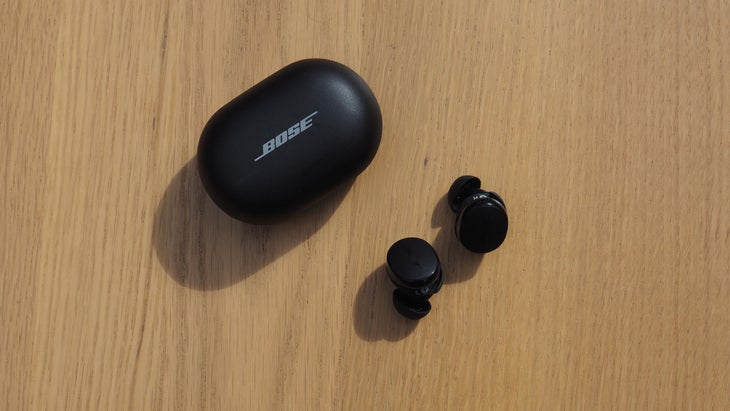
Best All-Around
Bose QuietComfort Earbuds
Pros and Cons
⊕ That reliable Bose sound
⊕ Excellent noise cancellation
⊗ Case feels a bit cheap
The most surprising thing about the new iteration of the QuietComfort Earbuds is the price, which has dropped from $280 in the first generation to $180. Bose also offers a premium model called the QuietComfort Ultra, which goes for $300. Surely the new economy model is lacking something those other versions had? Not a whole lot, as far as we could tell.
The new model is anchored on what Bose is best known for: smooth, warm sound that’s well balanced, with no overblown bass-iness and nothing too tinny on the high end. The QC II also comes with active noise cancellation that performed well, for example, when running on a windy day. With various sizes of fins that help you find a secure fit, they proved above average as workout earbuds, although parkour practitioners will probably experience slippage. The charging case has a slightly cheap plastic feel but is perfectly adequate.
The QC IIs come with their own app, which testers found easy to use; one “greatly appreciated being able to modify the touch controls, which I tend to dislike in earbuds, via the app.” If you’re one of those people, you’ll like the options for voice control, which let you pause, answer calls, and even take a selfie just by saying so. The battery life is very good, at 8.5 hours on medium volume with ANC turned on, and the charging case supplies 2.5 extra charges. With IPX4 water resistance, they repel splashing water but won’t be happy if submerged. And Bluetooth Multipoint means you can connect a phone and a laptop at the same time, without needing to fuss with Bluetooth settings every time you make the transition.
There’s nothing unexpected here—aside from the low price—and that’s a good thing. The QuietComfort II performed like a champ and had a just-right feel, and it’s always nice to pick up some excellent Bose tech and still afford to take your partner to dinner on Friday.
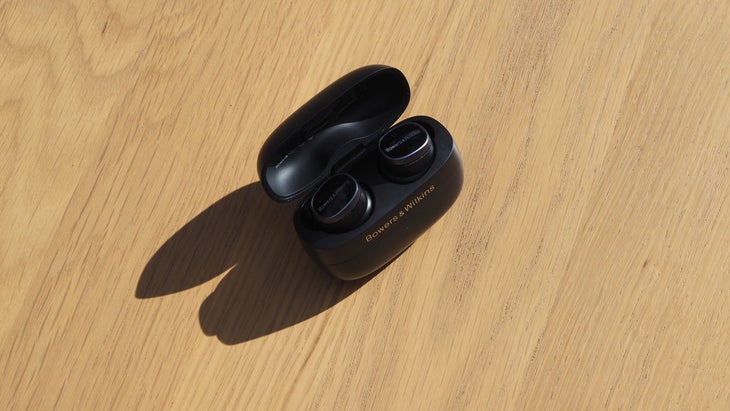
Best for Audiophiles
Bowers & Wilkins Pi8 In-Ear True Wireless Earbuds
$319 at Best Buy $319 at Amazon
Pros and Cons
⊕ Pristine sound quality
⊕ Non-frustrating touch controls
⊗ Not cheap
“The most audiophile worthy of all the earbuds I’ve tested,” one of our veteran reviewers gushed after a month with the Pi8s. Through hours of listening sessions on planes, on trails, on couches, and on city sidewalks, this was the pair that invariably impressed everyone on our test team, with their “incredibly balanced and musical” sound quality.
The $400 price—$150 above Apple’s ubiquitous AirPod Pros and $100 north of the Bose QuietComfort Ultras—means you have to be serious about your music, and about taking good care of them. They’re IP54-rated, able to handle sweat and a misty rain, but are not the pair you want to bring to the gym each day. While the four sizes of ear tips help them sit pretty securely and comfortably, they will fall out on occasion. All the same, we won’t discourage you from ever bringing them on a run on a sunny day, where their high-fidelity clarity is sure to put a little more oomph in your step.
The active noise cancellation on the Pi8s is excellent, similar to that on the Bose QCII, with touch controls for toggling between on, off, and transparency mode. The touch controls work better than in most earbuds we’ve seen, with a satisfying light noise that’s akin to a mouse click. We also love the pearlescent finish on the outer surface of the Pi8s, which come in four colors. A robust companion app lets you turn off the touch controls and has a five-band equalizer so you can tweak the sound profile to your liking. Battery life here is an average 6.5 hours, and the charging case holds two additional charges (13.5 hours).
Another nice feature is something called retransmission. This allows you to use the included USB-C-to-3.5mm cord to plug the unit’s charging case into an external device like an in-flight entertainment system and the case will send the signal into the buds, so you’re not stuck listening on that plastic-wrapped pair the flight attendants hand out with the peanuts.
One reviewer reported, “I listened to an album with two double basses—“But Who’s Gonna Play the Melody?” by Christian McBride and Edgar Meyer—and I could hear their fingers and the pull of the bow on the strings in ways I hadn’t before.” That’s a good example of what makes these shine like few have before them.

Best for Runners
SoundPeats Q35 HD+ Neckband Headphones
$43 at Sound Peats $30 at Amazon
Pros and Cons
⊕ Impossible to lose
⊕ Lightweight
⊗ Struggles with heavy bass
⊗ Cord can annoy some
If impressive sound coupled with a secure fit is what you’re after, this is the model for you. The Q35 HD+s are held firmly in place by semi-rigid fins that position them snugly—something we’re surprised more earbuds don’t come with—while a barely there cord wraps behind your neck. If you drop and do push-ups and gravity pops the buds out, the cord makes it impossible for one to roll away into the shrubbery to be lost forever. It’s a satisfying package: light but with a sturdy build, and easy to spool into your pocket when you stop for coffee.
It’s a form factor that’s been around for years and, as one tester who runs routinely notes, has been perennially dependable. What we didn’t expect, for the bargain price, is something that sounds this good. The sound is not as detailed or as robust in the low end as the Bose or B&W models, but you’re certainly getting more than you paid for. For a heart-pumping track like the Who’s “Baba O’Riley,” they sound good enough for hours on the trail.
And time on the trail is another thing they’ve got covered: The company rates them at 17 hours on a charge, after which they get plugged back in—no backup power in the carrying case, which is flimsy but does fine at protecting the device and keeping the cord from tangling with the other stuff in your backpack.
IPX5 water resistance means they’ll have no problem with a light rain and should not be impacted by moisture on a long, sweaty day on the trail. And the mic built into the inline control module means the Q35 HD+ handles phone calls well—with the proximity to your mouth arguably capturing your voice better than the mic on a wireless earbud can. It’s an impressive piece of gear that could have just as easily slotted into our Killer Value category.
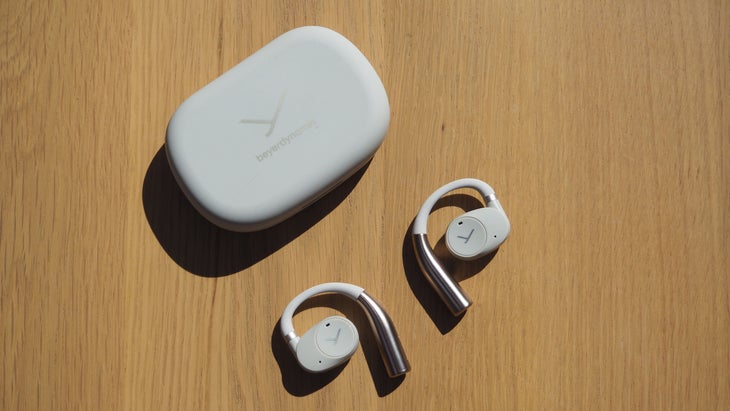
Best Open Ear
Beyerdynamic VERIO 200
$220 at Beyerdynamic $200 at Amazon
Pros and Cons
⊕ Best-sounding open-ear model
⊕ No discomfort inside your ears
⊗ Ear hooks can be uncomfortable
Cycling on a city street while dialing in to the all-hands meeting? Hiking with a buddy and wanting to switch between conversation and catching up on your podcasts? Knocking out two chapters of Moby-Dick on Audible on your daily run? All these use cases have their perfect companion in the VERIO 200.
And this is leaving out music, which historically (in our test team’s estimation) has sounded too weak and tinny in the open-ear design but now, at last, is starting to approach the real thing. Rock ’n’ roll will probably never shine with this form factor, but it’s never come closer than this. Thanks to the wizards at Beyerdynamic, classical and jazz came through with a clarity that one tester called “better sounding and generally more sophisticated than previous attempts at open ear.”
The VERIO 200s play for eight hours on a charge and have a well-designed case that provides 27 more hours. (Some found the case a little large, but others appreciated that the earpieces slide in so seamlessly, without the multiple repositioning attempts required with some brands that use a smaller case.) The dual mics make them very effective for calls, and an IP54 rating makes them suitable for runs and walks in a light rain—or for a sweaty CrossFit workout, where they’d do a good job of staying in place thanks to an effective wraparound design. (Some reviewers, however, found them uncomfortable after an hour or so.)
Of course, safety is the main motivator for going to an open-ear design, and even at full volume the VERIO allowed the sound of fellow bikers and pedestrians to be heard. Returning home, we loved being able to leave them on for hours more, listening to the news or a ballgame while being able to chat with family, with no pausing or bud removal required.
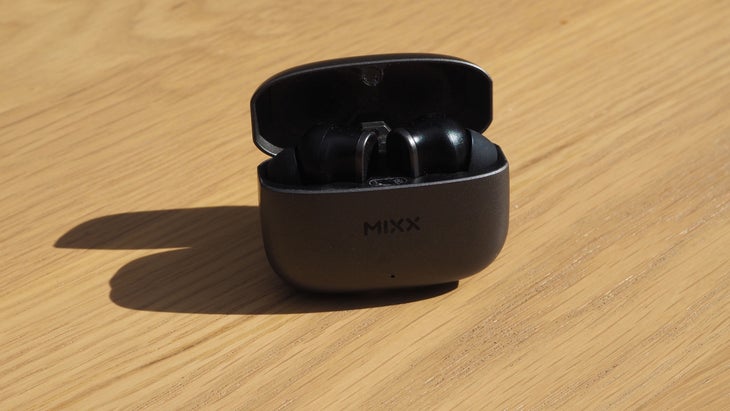
Killer Value
Mixx StreamBuds Custom 1
Pros and Cons
⊕ Compact
⊕ Surprisingly loud and clear
⊗ Small size means easy to lose
⊗ No IP rating
The Custom 1, from UK-based Mixx, delivers a really impressive sound at a great price. Out of the box, the first thing that charmed us was the size of the case, small enough to close your hand around. The earbuds themselves are small too—a fact that made them coveted by my wife, who can’t deal with anything too bulky sitting in her ears.
That tiny case is also tough, made of zinc alloy that looks sleek and can handle being dropped, stepped on (we tried it out), and generally tormented. Said case charges the Custom 1s for six hours of playtime and carries three extra six-hour charges: pretty impressive for such a wee thing.
But it’s the Custom 1’s well-detailed acoustic quality that won us over: “Music sounded warm, with good lows, though sometimes a bit muffled,” said one tester. Others also echoed the word “warm”—they seem to offer a certain rich quality that makes orchestral music shine through.
The Custom 1s sounded great on runs but are definitely not the most secure, and at their size, you’ll be nervous about losing them. “I preferred them for walking rather than more active running or hiking,” one tester remarked. Nor do they come with any IP rating for water or dust resistance; this doesn’t mean they can’t handle moisture, but apparently the company didn’t do that testing. If you’re a fan of compactness, if you have smaller ears, or if you simply like discovering hidden gems at a bargain price, however, this is one to add to the mix.
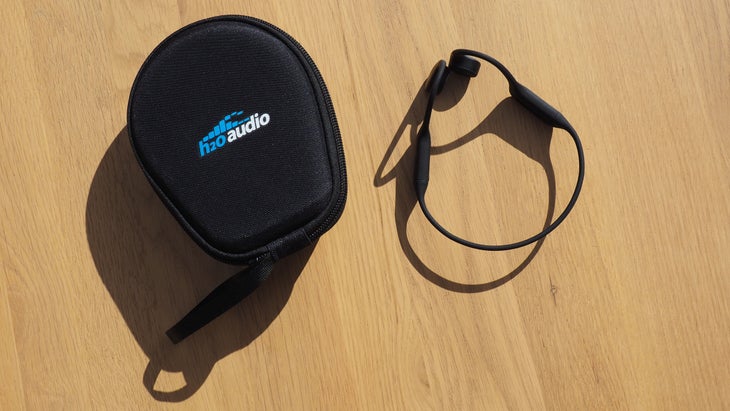
Best for Water
H2O Audio TRI 2 Pro
$199 at Best Buy $199 at Amazon
Pros and Cons
⊕ Totally waterproof
⊕ Onboard memory
⊗ Song transfer is slow
⊗ Can cause tickling
Have you harbored dreams of funneling techno into your auditory nerve while windsurfing on San Francisco Bay, then voice-commanding to switch over to an incoming business call? One member of our review crew put three models of waterproof earbuds through this very test and, while the process stands to be improved through future innovations, it worked fairly well, with the TRI 2 Pro coming out on top.
H2O Audio has been selling good products for swimmers and the like for years—it takes a special approach, not least because they need to be IPX8, able to go 12 feet underwater for as long as you want them to—like this model can. And, of course, a Bluetooth signal won’t travel under the waves with you, so tracks need to be stored locally, either on a waterproof MP3 player or an even better solution, like this unit’s 8GB of onboard memory that can store 130 hours of tracks. (It can move your own mp3 files over or “record” music from a streaming service like Spotify, though this is a slow process.)
The TRI 2 Pros employ bone conduction technology, which makes them great for podcasts while out on a run or bike ride, but a little less ideal when trying to rock out in said open-air activities: Then they can start to tickle. Still, H2O Audio and other companies are making these units sound better every year. And it’s underwater that they really shine: When you use the included earplugs to neutralize the water noise in your ears, it’s surprising how smooth music sounds, and at much more moderate volumes. They’re a minor godsend for lap swimmers, snorkelers, and triathletes (presumably the core audience for the Tri line) who like to enhance their life aquatic by playing their favorite symphony or devouring an audiobook. The headset will play for up to nine hours in Bluetooth mode and six hours in memory mode and comes with a zip case (which is rather bulky) that provides two and a half refills.
Back to our windsurfer: The TRI 2 Pro worked under a helmet (and this success was replicated on the ski slopes), which also secured them in the event of a fall. Playing tunes when the wind was low was enjoyable, but in high wind it was a challenge: “I could hear the music, but the output of the headphones had to compete with the roar of wind in my ear canals. It’s simply a matter of physics.” This also meant the tester’s hopes of “turning sales meetings into sails meetings” by joining conference calls were largely dashed. Listening worked fine, but the microphone couldn’t pick up his voice from deep inside his helmet. Maybe one day.
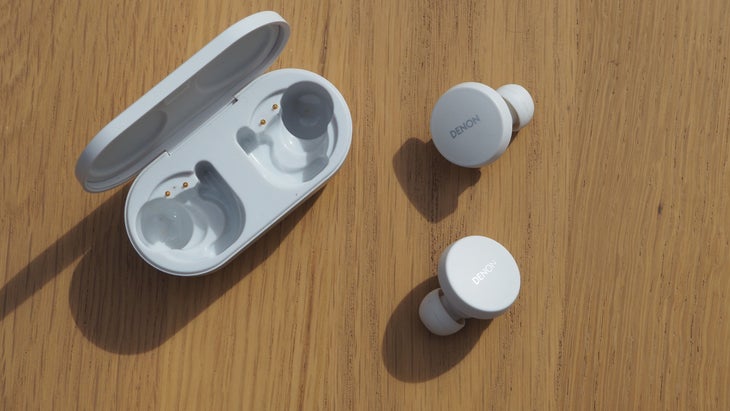
Most Innovative
Denon PerL True Wireless Earbuds
Pros and Cons
⊕ Rich, dynamic sound
⊕ Impressive app
⊕ Customizable sound profile
⊗ Chunky size
“Each product is hand-tuned by our sound master,” Denon says of the PerLs, and while we don’t know exactly what that means, it speaks to the Japanese DNA in these premium-sounding buds. Take the accompanying software, for instance: The first thing you do with these wireless buds is download an app that streams a series of sounds and frequencies into your ears to measure how you hear, then creates a personalized profile that transforms how good music sounds. It’s one of the best uses of a headphone app we’ve seen.
The PerLs came across as lively but not piercing on the high end, with realism and verve. There’s even a high-gain option on the app that boosts volume for quiet recordings, which one tester called “a welcome feature that I would love to see in a lot of sometimes anemic Bluetooth earbuds.” These capabilities are made possible by a series of ultra-sensitive microphones, which probably explains their rather enormous size—one reviewer called them “sharp-edged Alka-Seltzer tablet earbud bodies” and noted, “I had to remove the supplied fin attachment before these felt okay.”
Others liked the fit and found them great for running, where they kept the adrenaline flowing with some of the best full-on rocking-out sound in the test. “St. Vincent and Spoon sounded like I was listening to vinyl,” one tester said. The active noise cancellation is decent, the six hours of battery is average (with two more charges from the case), and an IPX4 rating means they can handle a light rain. Given the quality and attention to detail, we consider these a true bargain at $139 or less.
How to Choose Earbuds
Earbuds are more like shoes than most other gear categories: so much depends on the right fit. What comfortably fits one person’s ears may not suit another’s, and there’s more to it than size. The internal anatomy of the ear makes certain designs actually sound better to one person than the next. If you can’t try them out at a store or borrow them from a friend, it may be best to buy them from a retailer with a good return policy. Once you have them in hand, do some real-world tests with the different tip sizes, and trade them in if you aren’t in love.
If you want to get serious about the perfect fit, consider aftermarket foam eartips, like these from Comply. In addition to helping with a more secure fit, they provide passive noise isolation, which can improve the experience with both ANC-equipped and ANC-less earbuds. Should fit issues persist, consider a model with behind-the-ear hooks like the Powerbeats Pro 2.
Also give some thought to which features do it for you: Some people like sleek touch controls, others prefer old-school push buttons; some like to tap for quick pausing, others would rather forgo that feature and pull out one bud to ask for directions, so as to avoid the annoyance of unwanted pauses every time your fingers go near them. And if you live in a rainy climate, be sure to choose ones with an IP (ingress protection) rating ending in 4 or higher (as all the models here do).
Finally, be aware that there are more specialized designs emerging and getting better each year–like these earbuds for swimmers, others for cyclists and skiers, and open-ear designs for those who want to stay more tuned in to their surroundings.
How We Test Sport Earbuds
- Hours of Testing: 246
- Test Environments: Running, hiking, dog walking, cycling, windsurfing, skiing, rock climbing, yardwork, car camping, conference calls, video streaming, noisy coffee shops
- Highest Elevation: 10,152 feet, Leadville, Colorado
- Lowest Elevation: 5 feet underwater in Lake Pleasant, Arizona
- Most Listened-To Tracks: Childish Gambino: “Lithonia,” The Cure: “Alone,” Drugdealer and Kim Bollinger: “Pictures of You,” Fontaines D.C.: “Favourite,” J Dilla: “Workinonit,” Kenya Grace: “Strangers,” Magdalena Bay: “Image,” Slowthai ft. James Blake and Mount Kimbie: “Feel Away,” Trent Reznor and Atticus Ross: “Challengers”
The first thing we do with any earbuds, headphones, or speakers is attempt to pair them with our phones without consulting the user manual: the quicker, more intuitive, and easier the Bluetooth setup, the more points scored. Then we put them through rigorous hours of testing doing the kinds of things Outside readers do—from dog walks to HIIT workouts, from fireside listening to our day jobs, which for one of us is at the local woodworking shop. Our testers, who range in location from Alaska to Berkeley to Santa Fe to New York City, spent hours in them, bouncing up and down on trails, treadmills, and trains.
Our team turns in reports on each product tested, providing a score from 1 to 10 for five different measures: sound quality, pairing and connectivity, fit and comfort, rain and drop protection, and user friendliness. Scores are averaged, with more weight given to sound quality and (knowing our audience) how well they stand up to the elements. Note: Battery life estimates in these reviews are based on manufacturer specs; it’s difficult to confirm those numbers, given the time involved and variances among user habits (different volumes, different uses, different functions enabled). Actual results may be 10 to 20 percent lower, judging from averages experienced in general testing.
Meet Our Lead Tester
Will Palmer has been testing gear for 21 years for Outside, where he was managing editor and copy chief for nine years. Based in Santa Fe, he has been a runner since 1984, and while the mile counts have decreased over the years, he’s kept motivated to head out the door on the hottest, coldest, and wettest days by the opportunity to test the best new products—and to commune with the junipers and piñons.
Source link
